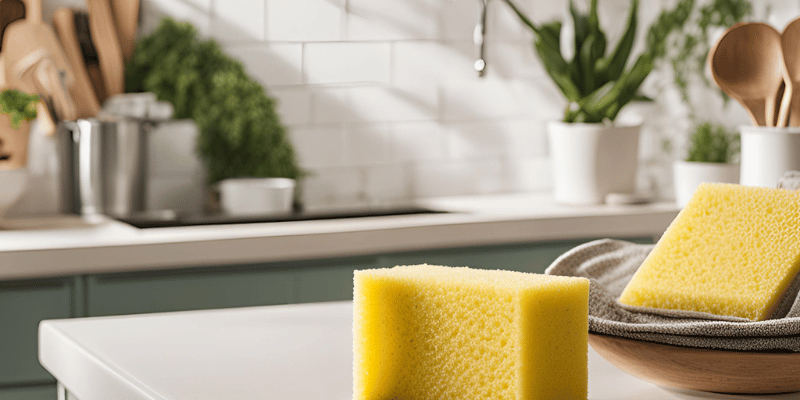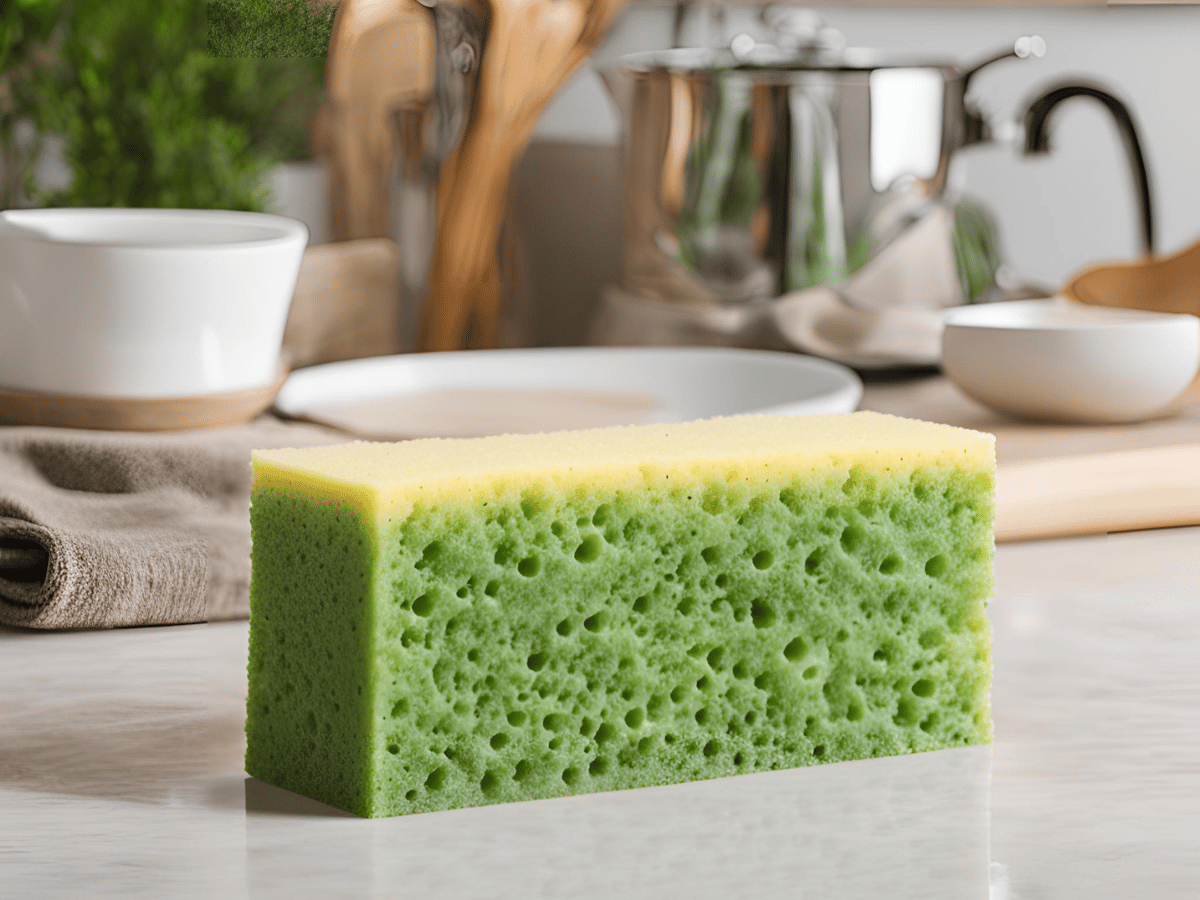Did you know your kitchen sponge might have more germs than your bathroom? It’s important to know how often to replace your kitchen sponge for your health and the planet. We’ll talk about why it’s key to replace your sponge often and how often. We’ll also look at the dangers of using a dirty sponge and green sponge options that help keep your kitchen clean and protect Earth.
Key Takeaways
- The kitchen sponge should be replaced every 1-2 weeks for optimal hygiene.
- Dirty sponges can carry harmful bacteria, impacting your health.
- Signs of a bad sponge include odors, discoloration, and a change in texture.
- Eco-friendly sponge alternatives like bamboo or natural loofah can reduce your environmental footprint.
- Regular cleaning and disinfecting can extend the lifespan of your sponge.
- Consider biodegradable cleaning tools for a sustainable kitchen.
The Importance of Changing Kitchen Sponge

Keeping your kitchen clean is key for your health. A big part of this is changing your kitchen sponge often. Sponges touch many food residues, making them perfect spots for bacteria. Knowing the dangers of dirty sponges shows why you should change them regularly.
Health Risks Associated with Dirty Sponges
Dirty sponges can hold dangerous bacteria like E. coli, salmonella, and listeria. These germs are a big risk for people who are more likely to get sick, like kids, the elderly, and those with weak immune systems. The mix of moisture and food bits is ideal for bacteria to grow.
Impact on Food Safety
Food safety is very important. Using dirty sponges can spread germs to food, utensils, and surfaces. This increases the chance of getting foodborne illnesses. Knowing how dirty sponges affect food safety highlights the need to change them often. This keeps your cooking area clean and safe.
How Often Replace Kitchen Sponge
Keeping your kitchen clean means knowing when to change your kitchen sponge. It’s key to replace sponges often to avoid bacteria buildup, which can be harmful. Experts say following a regular replacement schedule is crucial.
Recommended Replacement Frequency
It’s best to swap out kitchen sponges every 1 to 2 weeks, especially if you use them daily. Sticking to a schedule keeps your sponge clean and safe. Knowing how often replace kitchen sponge is vital for a clean kitchen.
Signs of a Bad Sponge
Spotting the signs of a bad sponge is important as time goes by. Look out for these signs that it’s time for a new one:
- Unpleasant odors
- Discoloration
- Excessive wear or tear
- Poor absorption
If you see any of these signs, throw the sponge away right away. Waiting can risk your food safety and kitchen hygiene.
| Signs of a Bad Sponge | Recommended Action |
|---|---|
| Unpleasant odors | Replace immediately |
| Discoloration | Replace within a few days |
| Excessive wear or tear | Replace immediately |
| Poor absorption | Replace immediately |
Understanding Kitchen Sponge Lifespan
The life of a kitchen sponge varies a lot due to key factors. Knowing what affects sponge durability helps you decide when to replace it. Experts say to replace your sponge every 2 to 4 weeks. But, many things can change this time.
Factors Affecting Sponge Durability
- Frequency of Use: Using your sponge every day can make it wear out faster.
- Storage Conditions: Keeping sponges damp can lead to more bacteria, making them last shorter.
- Cleaning Practices: Cleaning your sponge often can make it last longer. Not cleaning it can make it break down faster.
- Quality of Material: Better quality sponges last longer than cheaper ones.
Average Lifespan Based on Usage
How often you use your sponge affects how long it lasts. For example, a sponge used a lot for dishes might only last a week or two. But, if you use it just for light cleaning, it could last weeks.
Checking your sponge regularly can tell you if it’s getting old. Look for signs like color change, bad smells, or visible damage. Knowing these signs helps you keep your kitchen sponge fresh and your cooking area clean.
Kitchen Sponge Hygiene and Cleaning Practices
Keeping your kitchen sponge clean is key to avoiding harmful bacteria. Regular care makes your sponge last longer and keeps your kitchen safe. Cleaning right can also lower the chance of spreading germs when you cook.
Daily Cleaning Methods
Simple daily cleaning can boost sponge hygiene. Here are some tips to follow:
- Rinse Thoroughly: Rinse the sponge under hot water for at least 30 seconds after each use. This removes food bits and dirt.
- Air Dry: Let the sponge dry completely. Bacteria love damp places, so good airflow keeps your sponge clean.
- Rotating Sponges: Use several sponges for different jobs and switch them often. This reduces wear on any one sponge.
Disinfection Techniques
To keep your kitchen sponge really clean, use disinfection methods weekly. Here are some top ways to do it:
| Technique | Instructions | Time Required |
|---|---|---|
| Bleach Solution | Soak sponge in a mix of 1 part bleach to 9 parts water. | 5 minutes |
| Microwaving | Wet the sponge and heat it in the microwave on high. | 1 minute |
| Dishwasher | Put sponge in the top rack and run a high heat cycle. | Varies with cycle |
These methods improve sponge hygiene and make cleaning more effective.
Eco-Friendly Sponge Alternatives

Many people are looking for eco-friendly sponge alternatives to lessen their environmental impact. They want to keep cleaning effective. There are many biodegradable options available for them to choose from.
Biodegradable Options: Bamboo and Natural Loofah
Bamboo dishcloths and natural loofahs are great for those wanting to reduce their carbon footprint. They break down much faster than plastic sponges. This makes them a wise choice for those who care about the planet.
Bamboo is also antibacterial, which keeps your kitchen clean. Natural loofah, from a plant, has a soft scrubbing texture. It’s perfect for cleaning various surfaces.
Reusable Cleaning Tools
Reusable cleaning tools are another great option that lasts a long time and stays clean. Here are some items you might want to add to your cleaning routine:
- Silicone scrubbers: These are flexible, long-lasting, and fight off odors and bacteria.
- Microfiber cloths: They catch dust and dirt well without needing harsh chemicals.
- Dish brushes with replaceable heads: You can swap out the heads when they get old, cutting down on waste.
By picking eco-friendly sponge alternatives and reusable cleaning tools, people can greatly lessen their environmental impact. They can still keep their spaces clean and tidy.
Tips for Replacing Kitchen Sponge Effectively
Replacing your kitchen sponge can make cleaning easier and safer. Knowing when to replace it and how to store it right are important. This keeps your kitchen clean and hygienic.
Best Time to Replace Your Sponge
It’s best to replace your sponge every week or two, based on how often you use it. If you use it a lot, it will wear out faster. Checking your sponge often helps keep your cleaning safe and effective.
Storage Tips to Extend Sponge Lifespan
Here are some ways to make your sponge last longer:
- Store sponges in a well-ventilated area to promote airflow.
- Ensure sponges dry completely between uses, preventing moisture buildup that encourages bacteria growth.
- Rotate your sponges regularly to maintain even wear and tear.
Following these tips can help your sponge last longer. This makes replacing your sponge part of a good cleaning routine.
| Storage Tip | Benefit |
|---|---|
| Well-Ventilated Area | Reduces moisture and odor buildup |
| Complete Drying | Prevents bacterial growth |
| Regular Rotation | Ensures even wear, prolonging lifespan |
Conclusion
It’s key to check how often you replace your kitchen sponge to keep your kitchen clean and safe. Using a new sponge cuts down on bacteria and keeps your food prep clean. Knowing when to replace your sponges by looking for signs of wear helps you make smart choices.
Choosing eco-friendly sponge options is also good for the planet. Sponges made from bamboo or natural loofah work well and are better for the earth. Using these in your cleaning routine is a step towards a healthier home and planet.
Knowing how to keep your kitchen sponges clean is crucial for a better cleaning routine. By sticking to cleaning and replacement schedules, you keep your home healthy and help the environment. These simple changes make your kitchen cleaner and support a greener future.
FAQ
How often should I replace my kitchen sponge?
You should replace your kitchen sponge every 1-2 weeks if you use it daily. Look out for signs like bad smells, color changes, and if it doesn’t soak up liquids well anymore.
What are the health risks associated with using a dirty sponge?
Dirty sponges can carry harmful bacteria like E. coli, salmonella, and listeria. These can cause serious food illnesses, especially in people like kids and the elderly.
How can I tell if my sponge needs to be replaced?
Check if your sponge smells bad, looks worn out, or doesn’t soak up liquids well. If any of these signs show up, it’s time for a new sponge.
What is the average lifespan of a kitchen sponge?
A kitchen sponge usually lasts 2 to 4 weeks. This depends on how often you use it, where you store it, and how well you clean it.
What cleaning practices should I follow to maintain kitchen sponge hygiene?
Keep your sponge clean by rinsing it well after each use and letting it dry completely. You can also disinfect it by soaking it in bleach, microwaving it for a minute, or running it through the dishwasher.
Are there eco-friendly alternatives to traditional kitchen sponges?
Yes, you can use eco-friendly options like bamboo dishcloths and natural loofahs. Reusable tools like silicone scrubbers and microfiber cloths are also good alternatives.
What are some tips for effectively replacing my kitchen sponge?
Set a schedule to replace your sponge every week or two. Keep them in a place with good airflow and make sure they dry out between uses. This helps them last longer and stay clean.
Why is it important to change my kitchen sponge regularly?
Changing your sponge often stops bacteria from building up. It keeps food safe, keeps your kitchen clean, and protects your and your family’s health.
Source Links
- Your Ultimate Guide to Kitchen Sponges: Lifespan & Cleaning – https://ecoboo.net/blogs/green-clean/your-ultimate-guide-to-kitchen-sponges-lifespan-cleaning-disinfecting-and-when-to-throw-them-away?srsltid=AfmBOorTH-Cki8iJ5ZlAdvKOaIz7tAKRElxRcDyvqm9Kn_MVwJo6z_lW
- Experts’ Advice: How To Disinfect Your Kitchen Sponge – Baltimore HCS – Home Cleaning Services – https://baltimorehcs.com/experts-advice-how-to-disinfect-your-kitchen-sponge/
- When to Throw Away a Kitchen Sponge – https://www.thisoldhouse.com/cleaning/23409522/when-to-throw-away-a-sponge
